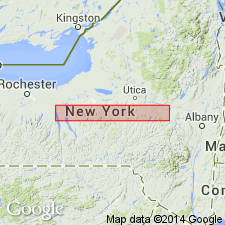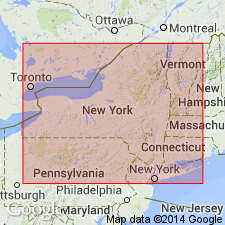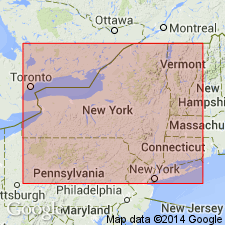
- Usage in publication:
-
- Moorehouse member
- Modifications:
-
- Named
- Dominant lithology:
-
- Limestone
- Chert
- AAPG geologic province:
-
- Appalachian basin
Summary:
Moorehouse member of Onondaga limestone named in Onondaga Co., NY. Composed of medium-gray, very fine grained limestone beds separated by thin shaly partings in many places. Chert common, but more abundant in upper nonshaly half. In west-central NY, limestone is coarser and lighter colored than in central area and seems to contain fewer impurities. Thickness 20 to 25 ft in type area. Maximum thickness about 50 ft. Underlies Seneca member; overlies Nedrow member (new) with transitional contact. Age is Middle Devonian.
Source: GNU records (USGS DDS-6; Reston GNULEX).

- Usage in publication:
-
- Moorehouse Member
- Modifications:
-
- Revised
- AAPG geologic province:
-
- Appalachian basin
Summary:
Three bentonites are herein named in the Moorehouse Member of the Onondaga Limestone: the First Cheektowaga Bentonite, the Second Cheektowaga Bentonite, and the Onondaga Indian Nation Bentonite. The last has been frequently mistaken for the Tioga, which is at the base of the Marcellus Shale, much higher in the section. The Seneca-Moorehouse Member boundary is also revised. Boundary has been placed until now at the occurrence of Hall's (1939) bentonite bed (here called the Onondaga Indian Nation Bentonite), but it is actually 1.9 to 4.1 ft above this marker bed.
Source: GNU records (USGS DDS-6; Reston GNULEX).

- Usage in publication:
-
- Moorehouse Member
- Modifications:
-
- Overview
- AAPG geologic province:
-
- Appalachian basin
Summary:
The Onondaga Limestone of NY is equivalent to the Selinsgrove Limestone Member of the Needmore Formation of PA and its four members are directly equivalent to the four members of the Buttermilk Falls Formation of eastern PA. Thickness of the Moorehouse Member of the Onondaga in west-central NY ranges from approximately 9.8 m at Seneca Stone quarry to about 14.9 m in the Stafford-LeRoy area. At the quarry, the lower 6.4 m is composed primarily of burrowed, sparsely fossiliferous calcisiltite with some chert. This lower portion contains several bands of highly argillaceous limestone or very calcareous shale that contain skeletal debris of small crinoids, trilobites, and brachiopods. Chert increases in abundance in the upper third of the member above a prominent calcareous shale bed loosely termed the "false Nedrow" shale. Near the top of the Moorehouse are the First and Second Cheektowaga Bentonite of Conkin and Conkin (1979). The upper is equivalent to the Tioga A Bed of PA workers. The base of Conkin's Onondaga Indian Nation Bentonite, called the Tioga B by Way and others (1986), marks the upper boundary of the Moorehouse. The lower boundary with the Nedrow Member is here drawn at the top of the dark gray SCHIZOPHORIA-bearing shale bed. This contact differs somewhat from that of other workers, who considered the contact to be 2.5 m higher at a thin shale containing quartz granules and pebbles. This thin shale, however, is not widely mappable. Age is Middle Devonian (Eifelian).
Source: GNU records (USGS DDS-6; Reston GNULEX).
For more information, please contact Nancy Stamm, Geologic Names Committee Secretary.
Asterisk (*) indicates published by U.S. Geological Survey authors.
"No current usage" (†) implies that a name has been abandoned or has fallen into disuse. Former usage and, if known, replacement name given in parentheses ( ).
Slash (/) indicates name conflicts with nomenclatural guidelines (CSN, 1933; ACSN, 1961, 1970; NACSN, 1983, 2005, 2021). May be explained within brackets ([ ]).

